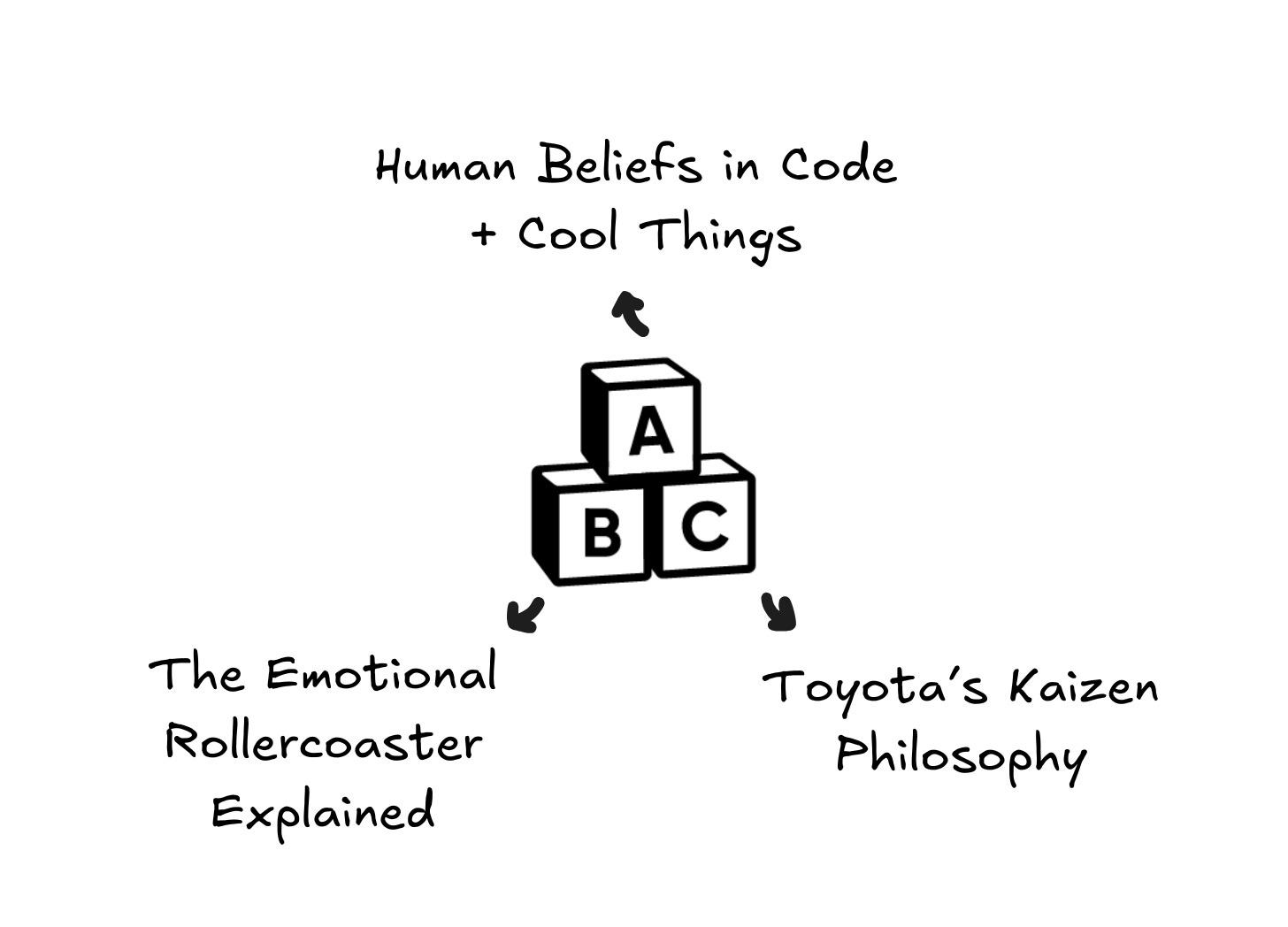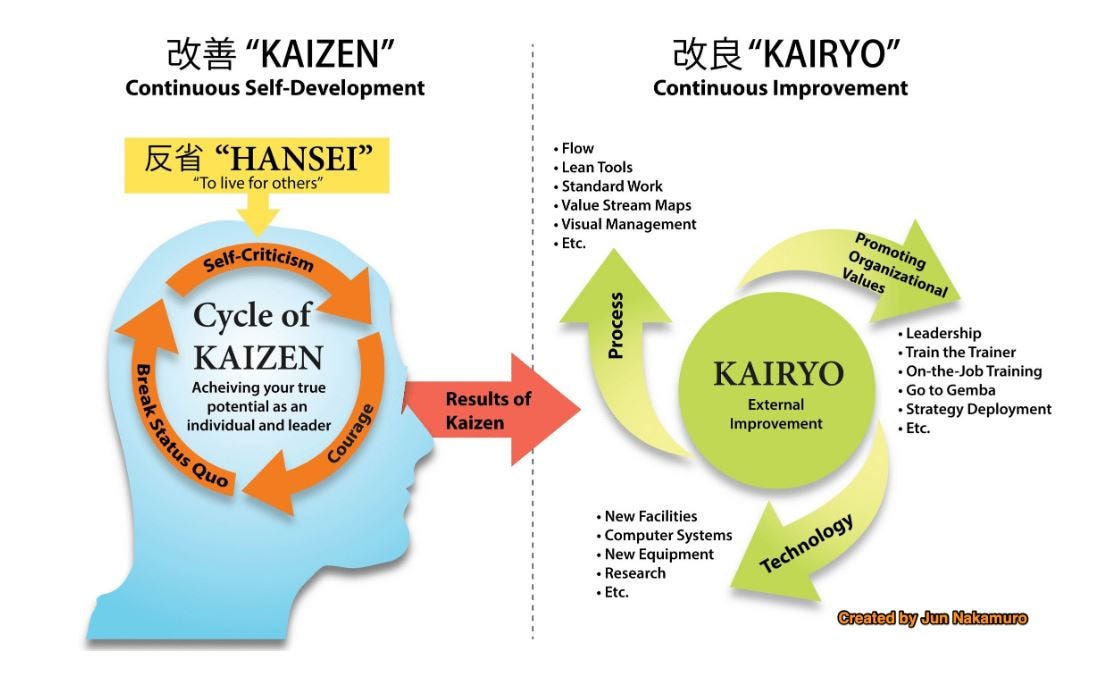🔤 How I Handle The Startup Rollercoaster
With one framework that changed my perspective entirely...
"Victory is not won in miles but in inches."
–Unknown
Being a founder is like trying to be Michael Jordan... in seven different sports simultaneously.
Think about it:
1. Someone has to sell the product
2. Someone needs to build the technology
3. Someone must install and support it
4. Someone has to design it
5. Someone creates demand
6. Someone counts the money
7. Someone improves the product
And in the early stages?
That someone is you.
And maybe spread across some Co-Founders, or a Founding Team.
Either way—lots of responsibilities and skills required to succeed, spread across a few people.
That’s why the Founder’s journey is such an EMOTIONAL rollercoaster.
You’re learning new skills, doing new things—ALL the time.
I’ve realized it’s important to get my mental game on lock.
Today, we go over an invaluable framework I wish I learned ages ago that has tremendously helped my mental game.
What's Inside This Week:
ALIGN: Human belief systems in code & cool things
BUILD: Epistemic Me updates & the real battle for founders
CULTURE: How Toyota leverages Kaizen in business
🤖 ALIGN: Human Belief systems in Code, and Cool Things
A few curated links and resources of recent topics around AI, health, longevity, business and product frameworks, cool tools, and general stuff I find interesting.
ABCs for Building The Future Episode 5 - Solving AI Alignment By Modeling Belief Systems In Code
Robert’s Take: We talked in more detail in this week’s podcast about our technical implementation of predictive processing, belief trees, and more for the Epistemic Me SDK. Join us as we dive deep on a use case—an AI Health coach, that hyper personalizes recommendations.
AI-Based Aging Clocks Offer Insights into Health and Lifespan
Robert’s Take: AI-Based aging clocks!?!? Just read this—I don’t know enough about this! Fascinating.
“Researchers at the Institute of Psychiatry, Psychology & Neuroscience (IoPPN) at King's College London have conducted a comprehensive study to evaluate artificial intelligence based aging clocks, which predict health and lifespan using data from blood.”
Luxury Doomsday Bunker with AI Medical Suites
Robert’s Take: There’s a lot of money going into Longevity from the rich and old (business and tech moguls, etc.). Makes sense, the older you get you realize you want to live longer and better. I think it brings up a good discussion point: the ethical implications and how we might ensure that such advancements benefit society as a whole, not just the privileged few.
🛠️ BUILD: Build In Public Updates and 1 Framework To Up Your Mental Game
"Success is not final, failure is not fatal: it is the courage to continue that counts."
—Unknown
Building In Public Updates: Epistemic Me
DISCOVERY WITH POTENTIAL CUSTOMERS:
We’ve been meeting with different developers who have use cases requiring “hyper-personalization”. After 15 minutes of pitching the product, one developer immediately jumped to asking "what's the price?". We’re still early, but the fact that they’re asking for cost means they see value, and they’re trying to do the math on ROI. Steps in the right direction. We have a ways to go in discovering the Ideal Customer Profile, and I believe we’re marching in the right direction.
PRODUCT PROGRESS:
Deen's been working on extracting belief systems of an influencer we’re prototyping something for, from their content on social media. Jonathan's been optimizing what we’re calling the “Belief Mirror” reference application, a Claude/ChatGPT style application where you can talk to an AI, but with one major differentiator—we allow you to examine what the AI believes about you. We think this is a good direction to demonstrate the power of the SDK.
DEPLOYMENT STRATEGY:
Given our bootstrapped status, we're leaning toward a self-hosted solution for any enterprise clients to start. It's a strategic choice that aligns with data privacy and sovereignty concerns while reducing our compliance burden.
CONTENT ENGINE:
Our content engine is getting more and more refined as time goes on. The podcast and newsletter pre-production, production, and post-production processes are getting more streamlined and taking less time every week. I see this as the foundation of our distribution channels.
Check out the podcast for more in depth “Build In Public” coverage.
The Emotional Cycle of Change
Here’s an amazing framework I wish I knew about when I was starting my own journey.
It’s called The Emotional Cycle of Change.
Don Kelley and Daryl Conner developed this framework and published it in the "1979 Annual Handbook for Group Facilitators."
In startup life, change is the only constant.
Here are the 5 phases in this cycle…
1. Uninformed Optimism
"We totally got this—we’re gonna change the world!"
You’re fired up, imagining all the benefits and barely noticing the challenges. It’s brainstorming, big dreams, and excitement. Everything feels possible.
2. Informed Pessimism
"WTF I didn’t know it’d be this hard."
Reality sets in. The costs of change feel heavy, and the benefits seem distant. Doubt creeps in, and you start questioning if it’s all worth it.
3. Valley of Despair
"Maybe a day job isn’t so bad."
This is the make or break point. Progress feels nonexistent, and quitting feels easier than pushing through. But giving up now means starting over later.
4. Informed Optimism
"Finally, we’re seeing results."
Momentum picks up. The benefits become visible, and the challenges feel manageable. You start believing again and push forward with renewed energy.
5. Success and Fulfillment
"Okay that wasn’t so bad, we made it through!"
The hard work pays off. The benefits are real, and the struggles were worth it. What once felt impossible is now routine. You’re ready for what’s next.
Rinse and repeat.
Reflecting back, I spent months in the Valley of Despair during my first startup.
Marketing was my kryptonite. I didn’t want to do it.
I was terrible at it—like F- terrible.
I ran away from it. I avoided it like the plague.
I tried to offload it to other teammates (mistakes made).
Looking back, this was one of my biggest failures (and learnings). I had to grow here to succeed long term.
In the past year, I’ve…
Devoured marketing books
Took courses
Studied copywriting
Tested strategies with a side business
Now?
I'm maybe a D+ in this set of skills, by my standard.
But that's the point—you don't need to be perfect, you need to be better than yesterday.
And as I put out content daily, I keep getting reps in to get better.
Eventually, I’ll get to A+.
It’s just a matter of effort over time.
When I zoom out, I realize the rollercoasters are just local minimums and maximums.
Highs and lows.
And the overall game, is about acquiring enough skills to reach the threshold for your situation, for breakthrough success.

"The cave you fear to enter holds the treasure you seek."
—Joseph Campbell
Being a founder means signing up for constant discomfort. You'll cycle through the phases of change over and over.
No founder has all the answers. Let that sink in.
Every entrepreneur has many "Valley of Despair" stories.
Those times when everything seemed impossible.
Maybe it’s every Monday. Maybe it’s once a month.
It depends on your business and where you’re at with it.
The most successful people didn’t succeed because they avoided the valleys—they succeeded because they kept going.
The key is to control what you can, and here are two questions I ask myself:
How can I minimize the time I’m in the Valley of Despair?
How can I minimize the depth of my Valley of Despair?
Answer: recognize when you’re avoidant, then run towards the thing you’re avoiding. Acquire knowledge, learn from others who are experts if you can, and charge through intentionally.
So next time you're in the Valley of Despair, remember…
1. This is normal
2. Everyone feels it
3. The only way out is through
And most importantly: You got this.
✌🏼 CULTURE: Japanese Kaizen Maps - The Secret Behind Toyota's $199B Success
I learned in recent years that Toyota's executives don't use traditional goal-setting—they use a Japanese business practice called Kaizen for continuous improvement.
When they focus on disciplined continuous improvement as a culture, they get collaborative network effects across all of their teammates.
From their website:
The English translation is, broadly speaking, continuous improvement. ‘Kai’ means ‘change’ and ‘zen’ means ‘for the better’. It is a philosophy that helps to ensure maximum quality, the elimination of waste, and improvements in efficiency, both in terms of equipment and work procedures.
Very cool stuff.
Want to dive deeper? Check out this article for more.
Liked this article?
💚 Click the like button.
Feedback or addition?
💬 Add a comment.
Know someone that would find this helpful?
🔁 Share this post.
P.S. If you haven’t already checked out my other newsletter, ABCs for Growth—that’s where I have personal reflections on personal growth related to applied emotional intelligence, leadership and influence concepts, etc.
P.S.S. Want reminders on entrepreneurship, growth, leadership, empathy, and product?
Follow me on..
💪🏼 How You Can Help
What's Next?
We're building something unprecedented: kind of an operating system for human understanding and beliefs.
If you're an engineer or builder who's ever felt the gap between technical capability and philosophical aspiration, we're building this for you.
Check out our website: https://epistemicme.ai/
GitHub here: https://github.com/Epistemic-Me
EM acts as a personalization layer and set of services that allows you and your applications to understand your users better. We have built a model and set of interfaces from first principles thinking in philosophy and epistemology to accurately map human belief systems.
What can that do for you?
→ Perhaps increase sales conversions.
→ Perhaps optimize copywriting in your automation funnels, depending on the user.
→ Perhaps helping researchers and scientists better quantify subjectivity in their experiments, for better science.
And… if you are looking for the “next best question” to evolve your beliefs, it could help you too.
In a few weeks we are going to rapidly get the structure to ship new features constantly, with new releases tied to this newsletter and our podcast.
Check out our first podcast on YouTube or Substack for a heavier deep dive into our “Why”.





